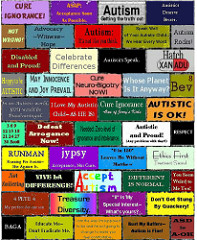“It’s not just me.”
I always feel ambivalent saying that. It’s part, “I’m not nuts or just being whiney, it’s real,” and part “I wouldn’t wish it on anyone else.”
Recent stories on BBC News describe how fluorescent light bulbs are not just good for saving energy — they can also be problematic for some people. The lighting can worsen skin rashes in people with photosensitive conditions, including, “the auto-immune disease lupus, the genetic disorder Xeroderma Pigmentosum (XP), certain forms of eczema and dermatitis, photosensitivity, and porphyria”
It has been estimated about 100,000 people in the UK with these skin conditions will be affected.
ME (Myalgic encephalomyelitis, AKA Chronic Fatigue Syndrome) was also mentioned.
Dr Colin Holden, President of the British Association of Dermatologists, said: “It is important that patients with photosensitive skin eruptions are allowed to use lights that don’t exacerbate their condition.”
The bulbs were also mentioned as potential triggers for migraines or epilepsy.
However, Karen Manning, from the Migraine Action Association, said this could be damaging to some sufferers.
She said that up to six million people in the UK suffer from some sort of migraine attack.
“These bulbs do trigger migraines for some of our members – it’s either the flickering, or the low intensity of the light, causing eye strain.
Some people with AD/HD or autism also complain about similar problems with fluorescent lighting.
Currently there is a plan in the UK to voluntarily phase out incandescent bulbs by 2011, as part of the effort to reduce overall CO2 emissions. This is important as part of the world-wide effort to reduce global warming; the US could stand to be more proactive.
But we need to remember the important tenant of Universal Design: there is no one perfect solution for everyone. Employers, schools and other organisations will need to be able to have options for people, as indicated by the ADA (Americans with Disabilities Act), DDA (Disability Discrimination Act) and similar rulings. Hopefully advances in LED lighting or other new technologies will result in other products that work well for various purposes.








sandi said,
17 September 2010 at 18:39
I worked under fluorescent lighting for years and suffered frequently from migraines, weakness, nausea, psoriasis and fainting. In recent years I’ve been diagnosed with Chronic Fatigue Syndrome and was told it’s quite common with people with Icelandic background…. in fact so common it’s called Iceland Disease. Since being away from fluorescent lighting for the last 2 years I’ve found marked improvement in my energy level and all other symptoms. I definitely believe there is a connection and that fluorescent lighting is a trigger in many people.
MaxJerz said,
7 June 2008 at 20:41
Andrea, I don’t know if you’ve seen this yet, but a group of us migraine bloggers have put together a petition, regarding the recent legislation passed by Congress that will start phasing out incandescent lighting in 2012. With the currently-available technology, this means that compact fluorescent lightbulbs are the most likely replacement. For many migraineurs (like me!) these are a big trigger.
I ask that you consider signing our petition, which you can find here: http://www.ipetitions.com/petition/migrainesCFLbulbs/index.html
I also wrote a blog post about this, if you would like to learn more about the legislation, its impact and our proposed solution: http://rhymeswithmigraine.blogspot.com/2008/05/migraineurs-and-cfls-crucial-public.html
Thanks for your consideration!
MJ
lisa said,
1 April 2008 at 18:59
i have been getting dizzy spells for about 2 months now and some almost to the point of passing out. I get he sweats and the tunnel visions, but lie down before I can pass out.
I would like to talk with the woman who has had these same symptoms and found out it is flourescent lighting.
I have this lighting at work and at home!
Sally said,
7 January 2008 at 11:22
Thanks Andrea – we know its not just us – everytime some new technology is rolled out, people whose brains/body systems can’t cope with man-made negative effects, get sidelined. Some of us just can’t keep up with man-made stuff – whether its noise, such as drills, grass cutters, pressured water washers, fan heaters, fan hand dryers, or light – because man is manipulating existing forms of light on the specturm and exposing us to it in an unnatural way through fluorescents.
To Ange – its not you (having a panic attack) its the environment attacking you !
I suggest anyone negatively affected follows up all the links to organisations dealing with this through the ‘Spectrum’ alliance.
Marla said,
5 January 2008 at 22:53
I think the light in my daughter’s school is one reason she came home so tired. She always complained about the lights. Most of the time at home, even in our soft lighting she wants all the lights off.
ange said,
5 January 2008 at 18:49
flourescent bulbs and warehouse type atmospheres trigger some weird fainting thing in me. It’s awful. I just get naseous, then start feeling faint and very hot, and if I don’t sit down and put my head between my legs and take deep breaths, then it escalates to a full blown panic attack and near blacking out. It took me over a year to make all the connections. The docs said you’re just having panic attacks, but why would I only have panic attacks in Costco, Office Depot, and Home Depot? And only sometimes. I avoid those types of places at certain times when my hormones are wacky (figured this out too) and no more fainting panic attacks. I don’t know what it means, except supposedly I am perimenopausal and flourescent lights in reflective/big? spaces aren’t good.
Migraine Chick said,
5 January 2008 at 18:29
I sit under flourescent light bulbs every day at work, and it kills me. I have to wear a baseball hat to cut down the eye strain. I’m sure this doesn’t help my migraines one bit. Thank you for the post.